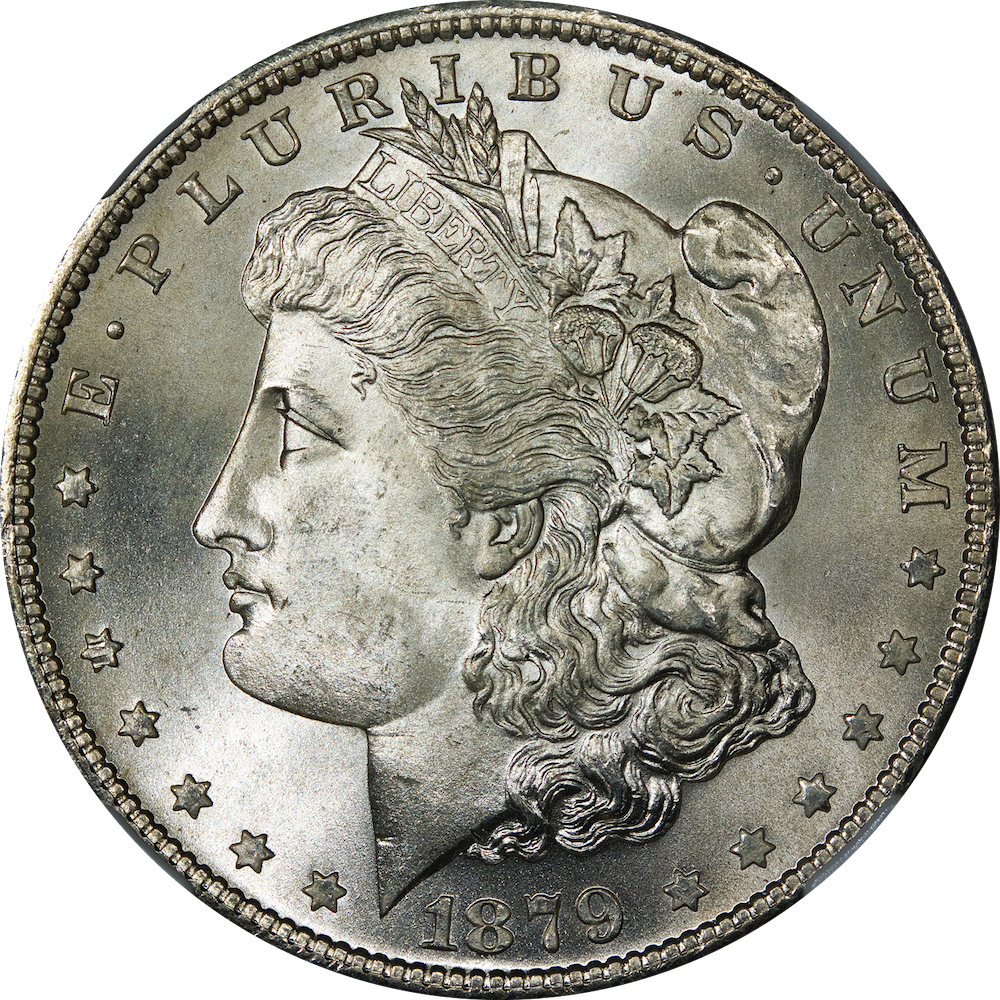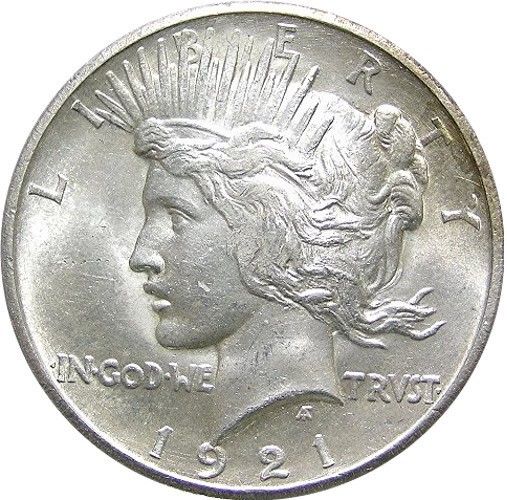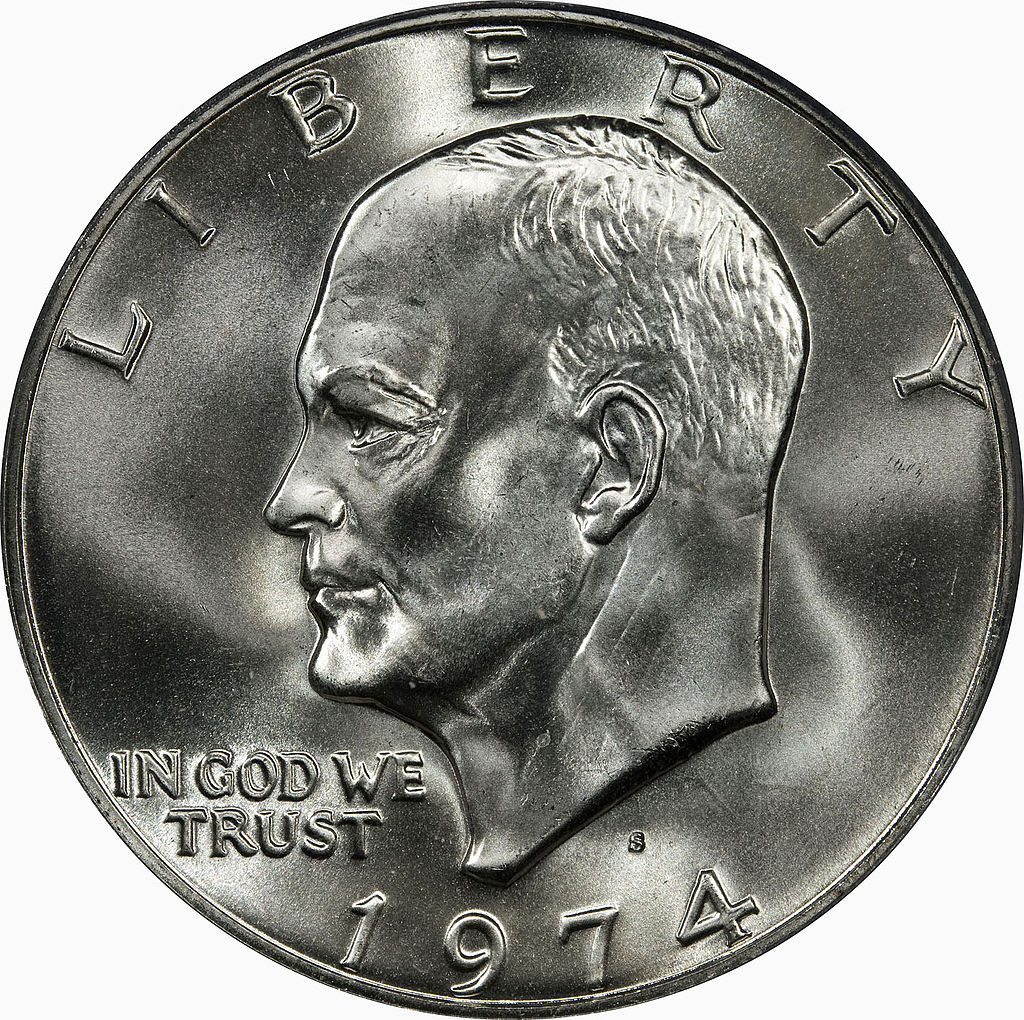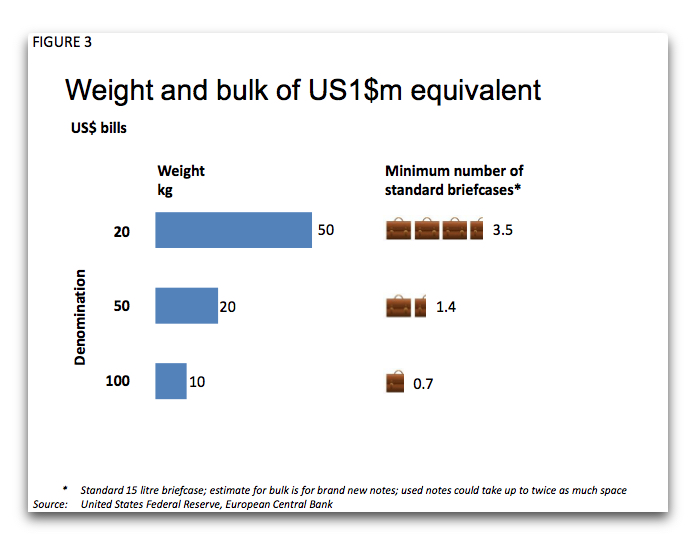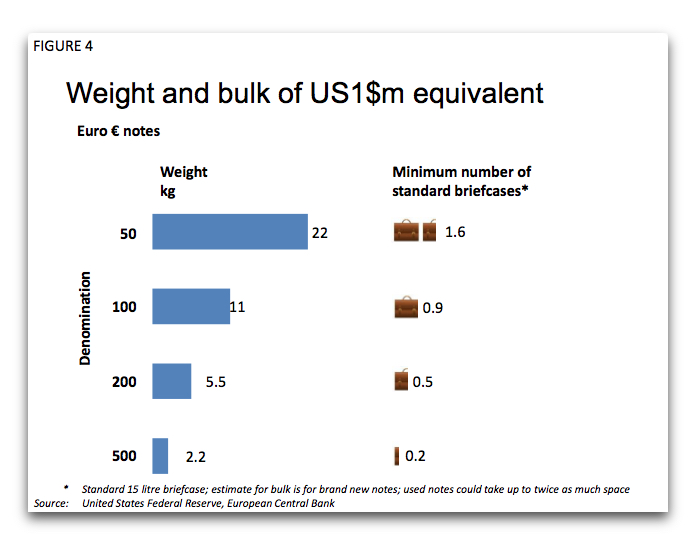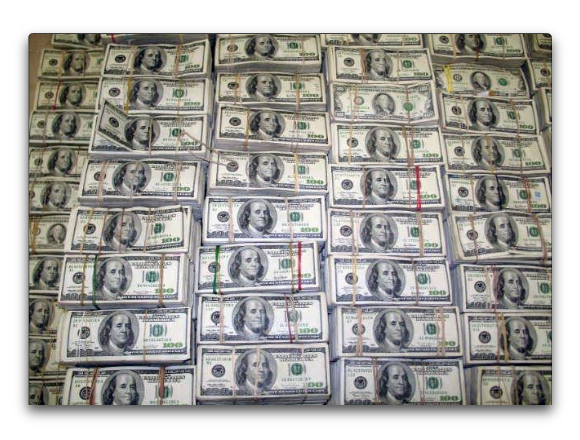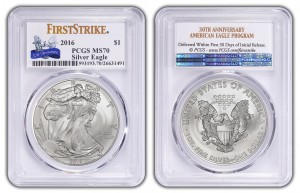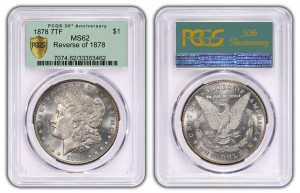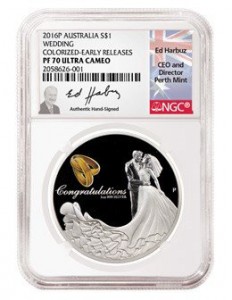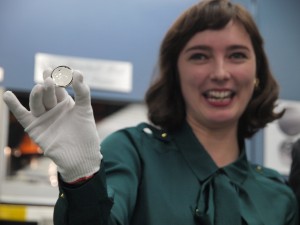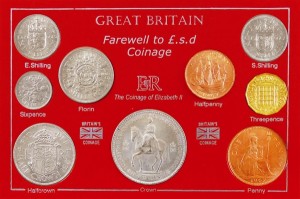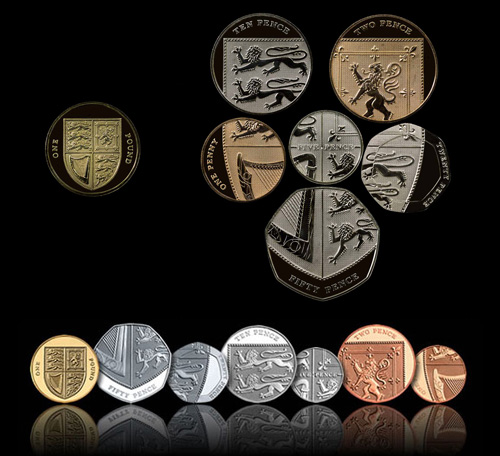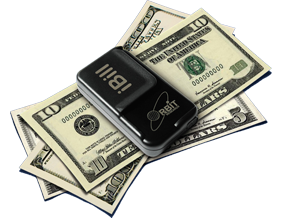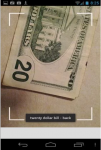Weekly World Numismatic News for April 18, 2021
WELCOME TO NATIONAL COIN WEEK!
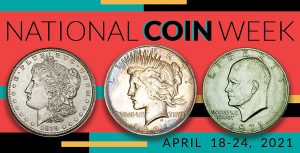 Starting today, April 18, 2021, through April 24, National Coin Week celebrates “Money, Big and Bold,” the history of the large dollar coin. The influence for this year’s NCW theme is the 100th anniversary of the revival of the Morgan Dollar and the first issue of the Peace Dollar. It is also the 50th anniversary of the first Eisenhower Dollar, the last of the large dollar coins.
Starting today, April 18, 2021, through April 24, National Coin Week celebrates “Money, Big and Bold,” the history of the large dollar coin. The influence for this year’s NCW theme is the 100th anniversary of the revival of the Morgan Dollar and the first issue of the Peace Dollar. It is also the 50th anniversary of the first Eisenhower Dollar, the last of the large dollar coins.
The dollar coin has had a fascinating history in the United States. Before paper money and during the wild days referred to as Broken or Obsolete Banknotes, before the National Bank Act of 1863, coins were considered safer than the barely regulated paper. As with many policies of the time, paper money was more in favor in the eastern United States than in the west. The west preferred the coins.
In 1918, Congress passed the Pittman Act, whose purpose was to supply the British with silver to help with their war effort. When the British repaid the United States, the government had to produce silver coins to replace coins melted to create the bullion shipped to Britain.
In 1921, the U.S. Mint had not produced a silver dollar since 1904 and did not have dies to produce coins. Chief Engraver and the coin’s designer Charles Morgan created new master dies to produce coins.
When the U.S. Mint discussed creating the new dies, former ANA President Farman Zerbe presented a paper at the 1920 World’s Fair of Money proposing the Peace Dollar. Congress eventually agreed, which led to the committee that picked Anthony di Franchisci’s design. Production of the Peace Dollar began in 1921.
The Peace Dollar almost made an appearance in 1964 when Congress proposed striking a new dollar coin. But the silver shortage and the end of using silver for circulating coinage ended this program. Allegedly, the U.S. Mint destroyed all 1964 Peace Dollar patterns.
In 1969, Mint Directory Mary Brooks wanted to issue dollar coins. As part of the negotiations with Congress to authorize a new coin, she suggested honoring the former World War II General and President Dwight D. Eisenhower. The suggestion convinced Congress to pass the legislation, and the U.S. Mint began Eisenhower Dollar production in 1971.
In 1975, the U.S. Mint was concerned with the level of resources required to produce the coin. Negotiations began to produce a smaller dollar coin. The results of these negotiations led to the introduction of the Susan B. Anthony Dollar in 1979, ending the production of the large circulating dollar coin.
All of the posts this week will be about large dollar coins except for Monday. Monday’s post will have a special announcement.
And now the news…
 → Read more at pennlive.com
→ Read more at pennlive.com
 → Read more at jacksonvilleprogress.com
→ Read more at jacksonvilleprogress.com
 → Read more at phys.org
→ Read more at phys.org
 → Read more at kitco.com
→ Read more at kitco.com
 → Read more at star-telegram.com
→ Read more at star-telegram.com
 → Read more at theguardian.com
→ Read more at theguardian.com
Is the $100 bill the next to go?
The latest attack on the money in your pocket is the talk about eliminating the highest denomination banknotes. This discussion was intensified in the political policy world with the article by Lawrence Summers that appeared in The Washington Post. Summers is a professor at Harvard and had once been the Secretary of the Treasury and Director of the White House’s National Economic Council.
Summers cites a paper by Peter Sands of Harvard and students that claims to make a compelling case to stop issuing high denomination notes and possibly withdraw them from circulation because of its use in crime and corruption.
Crime is mostly a cash-based enterprise. Criminals do not use gold, checks, or credit cards. As those of us who use cash over other payment types understand, cash is more anonymous. Cash transactions can be used to perform untraceable transaction that could be used to evade taxes. Criminals use cash to avoid law enforcement and terrorists use cash to fund their activities outside of the monitoring of financial transactions. In fact, Sands notes that these criminals have nicknamed the €500 note the “Bin Laden.”
In order to carry out cash-based transactions is the ability to carry the cash. Sands’ paper and Summers’ article both say that lower denomination currency will make it difficult to carry large volumes of currency in order to make these transactions. Considering the weight of United States currency, carrying $1 million worth of $100 Federal Reserve Notes would weigh about 10 kilograms (22.0462 pounds). Using a 15 liters (just under 4 gallons) as the “standard” briefcase capacity, you could carry $1 million in 0.7 cases.
As a comparison, $1 million worth of $50 Federal Reserve Notes would require 1.4 briefcases and 3.5 briefcases when using $20 notes. If the $1 million was being paid using €500 notes, it would weigh 2.2 kilograms or about 4.85 pounds that takes up a quarter of a briefcase.
Sands says:
Summers agrees with Sands and even suggests that the baseline currencies, specifically the dollar and the euro, should “stop issuing notes worth more than say $50 or $100.” Both consider demonetizing these high denomination notes a step in the right direction.
In the world of policy analysis there is the concept of the three-legged stool. The first leg is to identify the policy, which is what Sands’ paper does. Next would be to translate the policy idea into something that could be used as the basis for a law. The final step is something to drive the policy to be considered by the lawmakers in order to do something with the policy.
This is how the one cent coin went from being 95-percent copper to being copper-covered zinc. There was the idea to change the composition of the coin in order to save money. After the idea, there was the research and the law writing that went into changing the composition. As part of that second-leg exercise was the creation of the 1974 aluminum cent pattern. Finally, by 1982, the costs were so out of line that it became the driver that forced action.
Although the article and report has been well discussed as part of the financial press it is not likely to be acted on in the near future. It is only the first leg. It will take time before this stool gets its two other legs.
POLL: Do you collect grading service labels?
In December, I coined a term “numismentos,” a portmanteau of numismatic + memento. I was reminded of that with the recent announcements from both major third-party grading services.
Professional Coin Grading Service announced that as part of their 30th Anniversary celebration that they created a series of labels for their slabs including a retro-green label similar to the first labels issued by PCGS 30 years ago. Some, like the Mark Twain “First Strike” label will only be available at shows like the recently held the Long Beach Expo.
Numismatic Guarantee Corporation continues their signature labels march adding Former Perth Mint Director Ed Harbuz to the list of signatures that includes Elizabeth Jones and John Mercanti. Of course NGC as its other numismento labels.
I was curious as to what my readers thought. Do you collect the labels? Do you look for the labels? Do you care? Take the survey and then weigh in with comments!
- Images of PCGS special labels courtesy of the Professional Coin Grading Service.
- Ed Harbuz images courtesy of Numismatic Guarantee Corporation.
You can design a coin
Have you ever looked at a coin and wondered where the design ideas come from? Have you ever said to yourself that you could do a better job? Then here is your chance!
 Beginning February 29, 2016, the U.S. Mint is having an open competition to design the 2018 World War I Centennial Commemorative silver dollar.
Beginning February 29, 2016, the U.S. Mint is having an open competition to design the 2018 World War I Centennial Commemorative silver dollar.
There is a caveat: you have to be an artist of some type and a U.S. citizen 18 years of age or older. Phase I of the competition is the evaluation of up to five examples of your work submitted digitally to the U.S. Mint who is hosting the competition committee. You have to be able to submit a digital portfolio. Even if your work is good and you think you can be part of the competition, you either have to be able to take a good picture of your work or find a photographer who can help.
The “expert jury” will review your portfolio and select no more than 20 artists for the second phase.
Phase II, those selected artists will be asked to submit one design along with a plaster model of both the obverse and reverse for the proposed coin. Only one artist’s design will be selected
The winning artist will receive $10,000 and have your name etched in numismatic lore for being the designer of the coin. For this, your initials will appear on the coin, the Certificate of Authenticity, and in places like the Red Book!
“Artists are expected to distill the program’s design theme to its essence, representing a complicated subject on a very small palette.” A silver dollar is 38 millimeters in diameter!
Application deadline is April 28, 2016.
Remember Cassie McFarland? She was the artist from California who entered the National Baseball Hall of Fame Commemorative Coin competition and won the design contest. This is the coin whose clad half-dollar won Coin of the Year honors for the most innovative coin on a commemorative that was just about a sellout (over 1 million coins struck).Artists are always looking for a something to add to their portfolio. McFarland has had her picture in nearly every major newspaper throughout the United States and the image here has made the rounds on social media. I hope she has been able to boost her career with this. She definitely deserves any attention she receives.
Think about it… your design on thousands of coins in the hands of collectors, preserved forever. Cassie’s design is. How about you?
Pounds, shillings, pence and the power of 12
A very short, simplistic, and incomplete history begins with the Norman conquest of England by William the Conqueror. His invasion of England from Normandy on the northern shores of what is France today in September of 1066 and coronation on December 25, 1066, marks the birth of what would become England.
During the next nearly 50 years, William I (1066-87), William II (1087-1100), and Henry I (1100-35), most of the emphasis has been to finish the conquest and consolidate the ruling under the single crown. The Treaty of Alton (1102) and the subsequent conquest of Normandy (1106) was capable of consolidating power and allowed Henry to attempt to create a sustainable government. Insurgencies from Whales, Rebellion of 1115-20 and the crisis of succession, where is his wife Matilda had not conceived a child, did not allow Henry to finish his work by his death in 1135.
The pound symbol is a fancied “L” based on the Latin librae for weight or balance. It was intended that the 240 pence could be placed on a balance to weigh one pound sterling. The shilling, adapted from the Latin solidus, for solid, was the primary coin of commerce represented with an “s.” For the pence, it used the “d” from the Latin denarius, the smallest Roman coin. Multiple denominations are separated with a slash. For example, 1 shilling can be written as “1/-” while 2 shilling and 3 pence might be written as “2/3d.”
Henry I was succeeded by Stephen, the grandson of William I, with much contention. The problem was that Stephen’s younger brother, Henry of Blois, was embraced by Henry I and subsequently by the Normans. The subsequent civil war lead to a period called “The Anarchy” (1135-1154). During that time Stephen tried to continue with Henry’s reforms but was not able to hold on to the control of the government. Toward the end of his reign, Stephen recognized Henry as the heir to the throne.
With a peace treaty negotiated by Stephen, there was a new peace during the coronation of Henry II in 1154. During the peace, Henry II continued to consolidate power of Norman and Anjou (today this is northern France) and reconstructed the English government.
As part of his reconstruction, Henry II decided to base the currency on the troy pound. The troy pound was based on the Roman libra, which was the basis of weight that England accustomed with. In order to make the money more acceptable, it was divided into 20 units which were originally called testoons. Later, it was renamed as the shilling. As an attempt to make the testoon (shilling) the major unit of currency which corresponded to the Roman solidus. As the solidus was divided into 12 denarii, the testoon was divided further into 12 units with one called a penny and multiples called pence. This was to keep current with the current standard that a pound sterling weight 240 pennyweights.
Early on, it was clear that pence was not small enough of a denomination and was further divided into four parts, two halfpennies or four farthings (quarter pennies). This division was used because the one pennyweight coin representing a penny could not be cut further to represent smaller denominations. Farthings were further divided into smaller denominations using tokes until coins were first used in the 17th century.
To understand this system, I came up with the following table.
| Denomination | Years struck | Equivalents | Relative to a Pound | Nicknames |
|---|---|---|---|---|
| Quarter farthing | 1839-1853, 1868 | 1/16 d (16 = 1 penny) | 1/3840 pound | |
| Third farthing | 1827-1913 | 1/12 d (12 = 1 penny) | 1/2880 pound | |
| Half farthing a | 1828-1856 | 1/8 d (8 = 1 penny) | 1/1920 pound | |
| Farthing | 1860-1956 | 1/4 d (4 = 1 penny) | 1/960 pound | |
| Halfpenny | 1672-1860 | 1/2 d (2 = 1 penny) | 1/480 pound | ha’penny |
| Penny | 1707-1970 | 1d | 240 pence = 1 pound | |
| Three halfpence | 1834-43, 1860-62 | 11/2 d | 1/160 pound | |
| Twopence | 1797 | 2d | 1/120 pound | |
| Threepence b | 1547-1970 | 3d | 1/80 pound | |
| Groat | 1836-1855, 1888 | 4d | 1/60 pound | joey, sixpenny bit |
| Sixpence | 1551-1970 | 6d | 1/40 pound | tanner |
| Shilling | 1503-1970 | 1/- (12 pence) | 1/20 pound | bob |
| Florin | 1849-1970 | 2/- (24 pence) | 1/10 pound | two bob bit |
| Half crown | 1707-1970 | 2/6p (26 pence) | 1/8 pound | |
| Double florin | 1887-1890 | 4/- (52 pence) | 1/5 pound | |
| Crown | 1707-1965 | 5/- (60 pence) | 1/4 pound | |
| Sovereign (pound) c | 1817-1917, 1925, 1957- | 240 pence | 10 Shillings | |
| Half guinea | 1699-1816 | 10/6d | 1/8 ounce of gold | |
| Guinea d | 1663-1814 | 21/- | 1/4 ounce of gold |
- Half farthing was originally made for Ceylon
- Three halfpence produced for circulation in the British colonies, mainly in Ceylon and the West Indies
- A one pound coin made of gold was called a Sovereign
- The guinea came into English after the Guinea region of West Africa was discovered by the British and mined its gold
- Not listed is “quid,” the nickname of a one-pound paper note
This was the system until Decimalization Day on February 15, 1971.
Today, British coins are divided into 100 pence to one pound. The coins struck for circulation by the Royal Mint are 1 Penny, 2 Pence, 5 Pence, 10 Pence, 20 Pence, 50 Pence or Half-Pound, £1 (pound), and £2. Paper currency is issued for denominations of £5 and greater.
- Image of pre-decimalization coins courtesy of Coincraft
- Image of 2014 United Kingdom shield set courtesy of the Royal Mint
Free Meaningful Access
The iBill currency reader is a product of Orbit Research. Retailing at $119.00, iBill is a pocket-sized reader that can identify all Federal Reserve Notes in circulation. Orbit Research claims that “most bills are identified in less than one second” and can announce “the denomination in a clear female voice; tone and vibration modes protect privacy.” It requires one AAA battery that is included.
The Meaningful Access Program came about as the result of a settlement between the government and the American Council of the Blind who brought suit claiming that U.S. currency violated Section 504 of the Rehabilitation Act. This was first confirmed by the courts in 2006 and subsequent appeals had judges requesting a settlement. Following the 2009 settlement, the BEP began to work on meaningful access programs.
One of their first attempts was EyeNote, an iPhone app the camera to scan the note and identify it in 2-4 seconds. Although slower than the iBill, it is a very capable app that will allow the visually impaired iPhone user to carry one less device.According to the BEP Meaningful Access mobile application page, the BEP worked in collaboration with the Department of Education to have the IDEAL Currency Identifier that works on Android devices. This app can be found on the Google Play Store.
A more impressive app is the LookTel Money Reader available for iOS and the Mac. For the visually impaired traveler, not only can Money Reader recognize U.S. currency, but the currency of 20 other countries including the Australian Dollar, British Pound, Canadian Dollar, Euro, Indian Rupee, Japanese Yen, and Saudi Arabian Riyal. Money Reader is faster at identifying currency than EyeNote and can identify fragments, as I found in my last review.
In order to qualify for the free iBill reader, a “competent authority” must certify that your vision is 20/200 or less in your better eye with corrective lenses or that the widest diameters of visual field angular distance not greater than 20 degrees or that the “competent authority” certifies that you cannot read any printed material regardless of correction. The competent authority is usually a doctor, registered nurse, licensed therapists, institutions and welfare agencies familiar with your case.If you think you, a relative, or someone you care for qualifies, download and fill out the simple form and send it to the BEP address on the form&rsqou;s instructions. It will take up to eight weeks for you to receive your free iBill currency reader.
As an aside, this is not a taxpayer funded venture. BEP earns its funding from their business operations. Most of their money is earned from printing money for Federal Reserve. They also earn a smaller amount of profit from sales to collectors.
- iBill image courtesy of Orbit Research.
- IDEAL Currency Identifier screenshot courtesy of IDEAL Group Inc. on the Google Play Store.
- All other images are property of the author.
